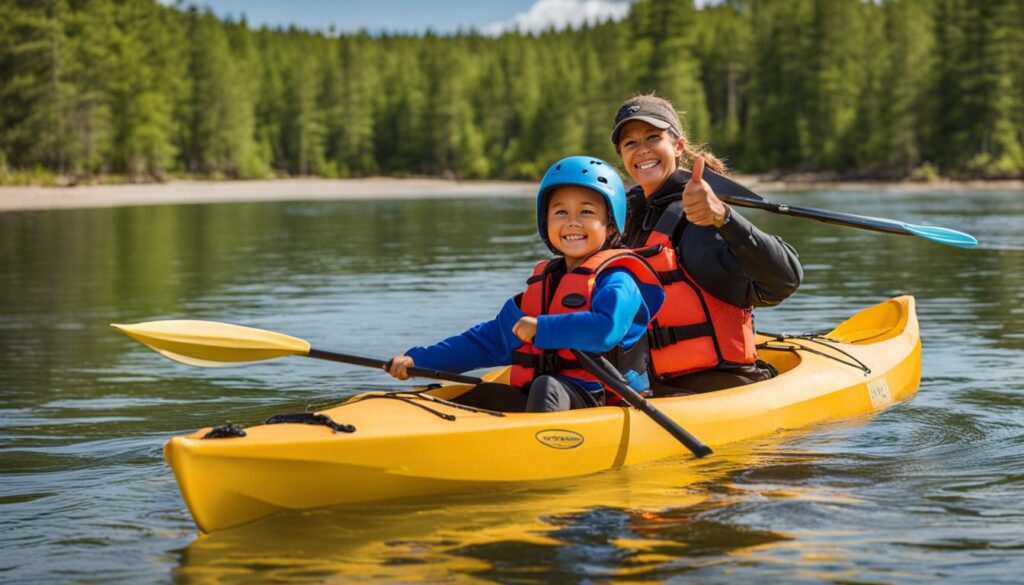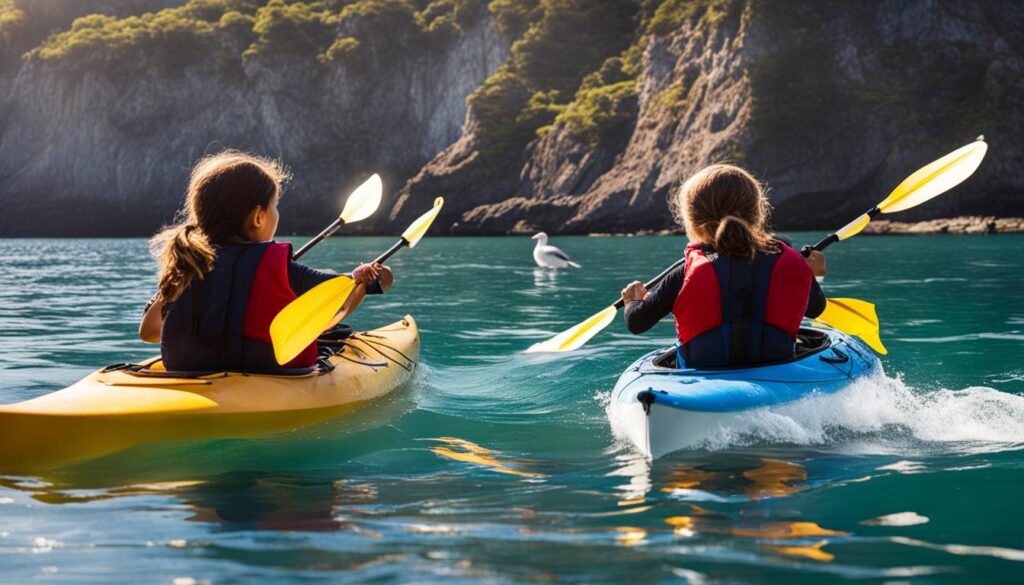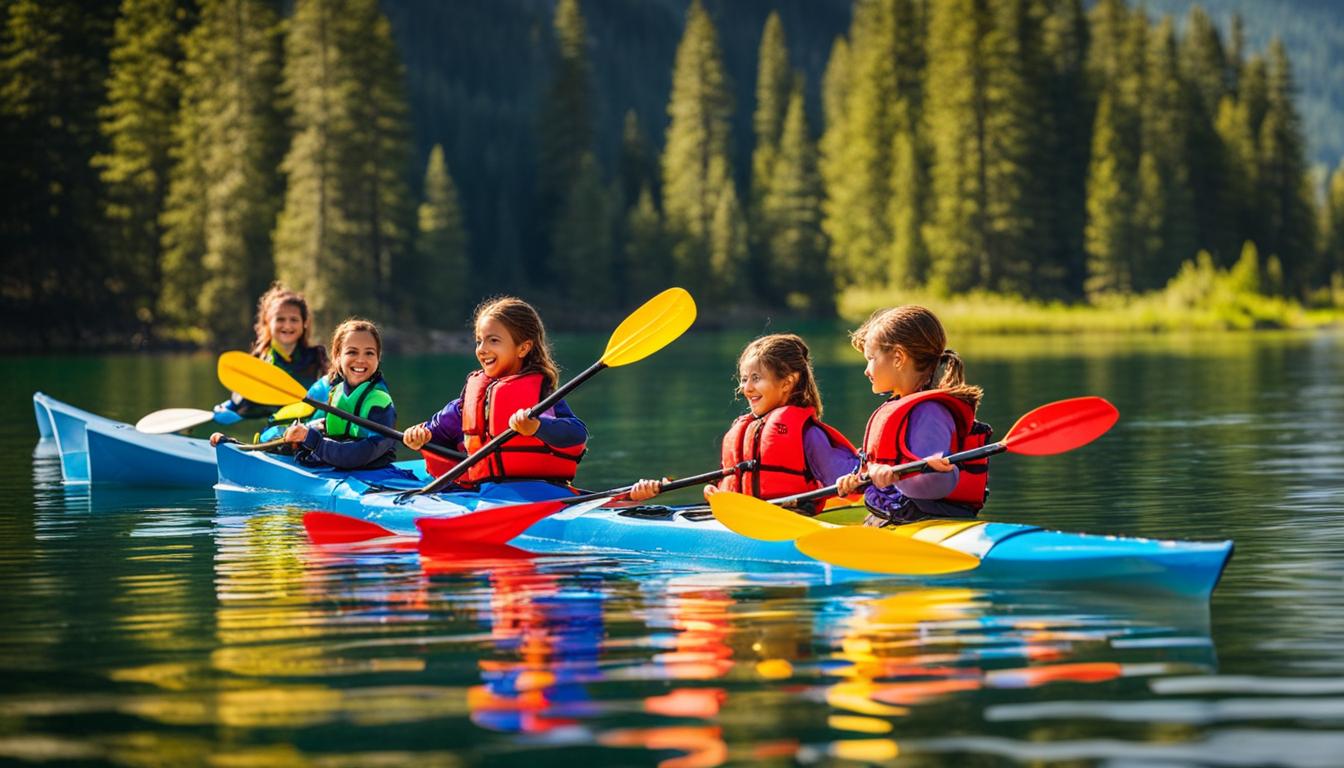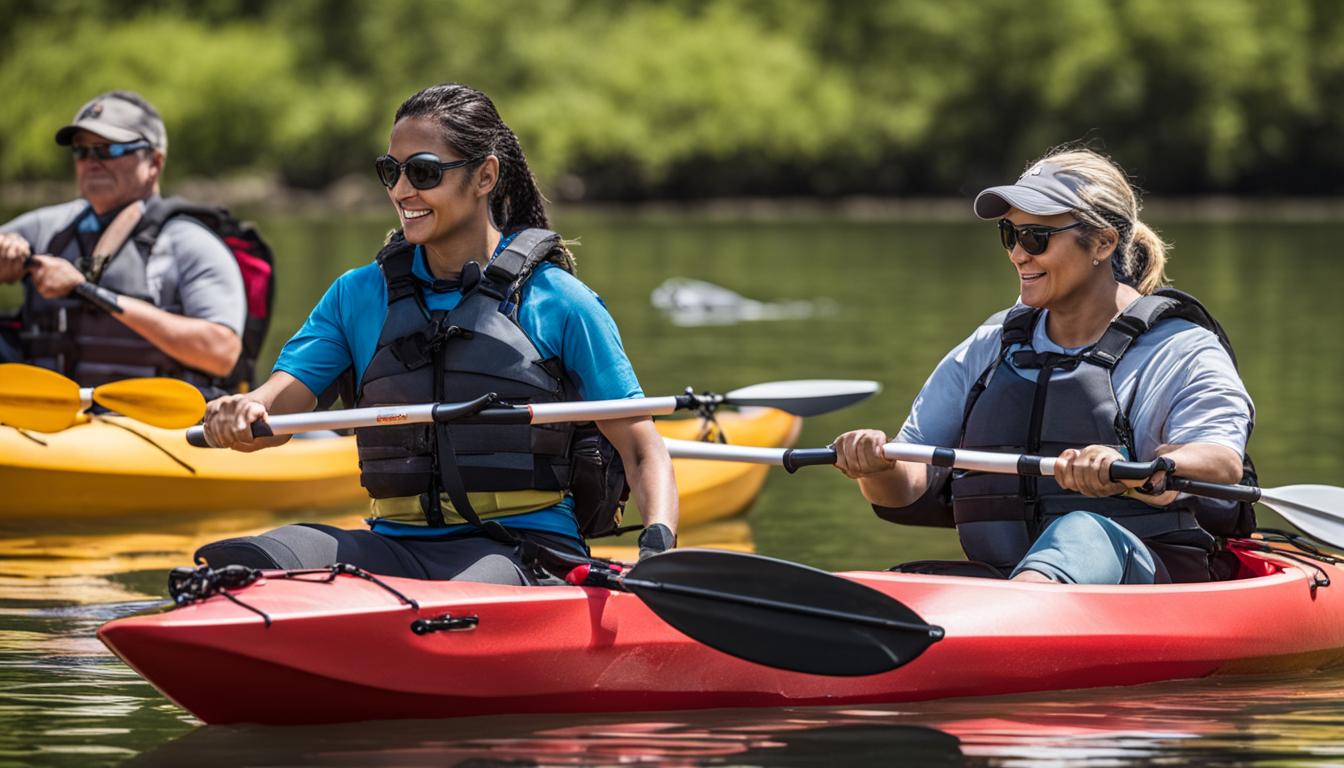Teaching kids paddle strokes is an exciting and fun way to introduce them to the world of kayaking. Kids can quickly learn the basics of paddle strokes, which will enable them to maneuver their kayak and enjoy their aquatic adventures. The basic paddle strokes to teach kids include the forward stroke, reverse stroke, draw stroke, pry stroke, and sweep stroke. It’s important to start in calm water and provide the necessary safety precautions, such as wearing a life jacket and having an adult nearby. By allowing kids to explore at their own pace and providing gentle guidance, they can develop their paddle control skills and have a blast on the water.
- Teaching kids paddle strokes is a fun way to introduce them to kayaking.
- The basic paddle strokes to teach kids include the forward stroke, reverse stroke, draw stroke, pry stroke, and sweep stroke.
- Start in calm water and prioritize safety by ensuring kids wear life jackets and have adult supervision nearby.
- Allow kids to explore at their own pace and provide gentle guidance to help them develop their paddle control skills.
- By teaching kids paddle strokes, you’re setting them up for a lifetime of aquatic adventures and fun on the water!
The Forward Stroke
In the world of kayaking, the forward stroke is the foundation of basic kayaking maneuvers for kids. It is the primary paddle stroke used to propel the kayak forward and move through the water with control and efficiency. Teaching children the proper technique for the forward stroke is essential in helping them develop their paddle grip and overall kayaking skills.
To execute the forward stroke, kids should start by rotating their torso and dipping one blade of the paddle into the water near the front of the kayak. They should then pull the paddle blade back, driving the kayak forward. This motion should be repeated on the other side of the kayak with the opposite paddle blade.
When teaching kids the forward stroke, it’s important to emphasize the correct paddle grip for young kayakers. Instruct them to hold the paddle with their large knuckles pointed up, ensuring the blades are oriented correctly. Encourage them to keep their hands relaxed on the shaft and use their stronger core muscles to power the stroke, rather than relying solely on arm strength. By mastering the forward stroke, kids will be well on their way to becoming confident and skilled kayakers.
| Benefits of the Forward Stroke: | Key Tips: |
|---|---|
|
|
The Reverse Stroke
Teaching children proper kayak handling skills, including the reverse stroke, is crucial for their safety and enjoyment on the water. The reverse stroke allows kids to slow down their kayak or move it backward when needed. By mastering this technique, children can gain better control over their kayak’s movement and navigate in different directions.
To perform the reverse stroke, kids should use the blade of the paddle to move against the water from back to front of the kayak. It’s important to emphasize the reverse motion and proper body rotation to effectively execute the stroke. By practicing the reverse stroke, kids can develop their coordination and balance, enhancing their overall kayak handling skills.
As with any new skill, it’s essential to provide clear instructions and patient guidance when teaching the reverse stroke. Encourage children to practice in calm, slow-moving water to build their confidence. Through repetition and encouragement, kids can improve their reverse stroke technique and become more proficient in maneuvering their kayak.
Kayak Handling Skills for Children
Teaching children the reverse stroke is just one aspect of developing their kayak handling skills. It’s important to cover other fundamental paddle strokes, such as the forward stroke, draw stroke, pry stroke, and sweep stroke. By introducing children to a variety of techniques, they can enhance their overall paddling abilities and explore different kayaking adventures.
| Kayak Handling Skills for Children | Description |
|---|---|
| Forward Stroke | The basic paddle stroke used to propel the kayak forward. |
| Draw Stroke | A stroke used to move the kayak sideways towards the paddle side. |
| Pry Stroke | The opposite of the draw stroke, used to move the kayak away from obstacles or the shore. |
| Sweep Stroke | A powerful stroke used to turn or spin the kayak. |
By teaching children these foundational paddle strokes, they can develop a solid foundation in kayak handling skills. As they gain confidence and experience, they can progress towards more advanced techniques and explore different types of kayaking adventures.
The Draw and Pry Strokes
When it comes to children’s paddling techniques, the draw stroke and pry stroke are essential skills to teach. These strokes allow kids to navigate their kayak in different directions and enhance their overall control on the water. The draw stroke is used to move the kayak sideways, while the pry stroke is the opposite and is used to push the kayak away from obstacles or the shore.
To perform the draw stroke, kids should hold the paddle with both hands, use one blade of the paddle, and face the side of the kayak closest to where they want to go. By pulling the water towards the side of the kayak, they can effectively move the kayak sideways and get closer to a dock or the shore. On the other hand, the pry stroke is performed by pushing the blade of the paddle away from the side of the kayak, which allows kids to move the kayak away from obstacles or the shore.
Teaching kids these strokes not only enhances their maneuverability but also gives them a sense of confidence and control on the water. It’s important to provide guidance and practice in a safe, controlled environment. By mastering the draw stroke and pry stroke, kids can navigate their kayak with ease and explore new areas of the water.
| Stroke | Description |
|---|---|
| Draw Stroke | Moves the kayak sideways by pulling the water towards the side of the kayak. |
| Pry Stroke | Pushes the water away from the side of the kayak to move it away from obstacles or the shore. |
The Sweep Stroke
Mastering the sweep stroke is a crucial skill for beginner kayakers. This powerful paddle stroke allows you to smoothly turn or spin your kayak, giving you greater control over your maneuvers on the water. Whether you’re navigating narrow passages, avoiding obstacles, or simply changing direction, the sweep stroke is an essential technique to learn.
To perform the sweep stroke, start by reaching as far forward as you can with your paddle. Then, use a sweeping motion to pull the paddle blade back towards the stern of your kayak. This sweeping action generates a wide arc of movement, allowing you to effectively turn or spin your kayak. Remember to maintain a relaxed grip on your paddle and engage your core muscles for maximum power and control.
When executing the sweep stroke, it’s important to differentiate between a forward sweep and a reverse sweep. The forward sweep is used to turn your kayak in the direction of the paddle stroke, while the reverse sweep is used to turn in the opposite direction. By practicing both variations, you’ll be able to navigate with ease and confidence.
Benefits of the Sweep Stroke
The sweep stroke offers several benefits for beginner kayakers. Firstly, it provides greater maneuverability, allowing you to make precise turns and navigate tight spaces. Additionally, mastering the sweep stroke helps improve your overall paddling technique, as it requires proper body rotation and engagement of your core muscles. Lastly, the sweep stroke enhances your safety on the water by giving you the ability to quickly change direction and avoid potential hazards.
Tips for Mastering the Sweep Stroke
- Start practicing the sweep stroke in calm, flatwater conditions before progressing to more challenging environments.
- Focus on maintaining a smooth and continuous sweeping motion, keeping your paddle blade close to the water’s surface.
- Experiment with different paddle angles and depths to find the most effective technique for your kayak and personal style.
- Don’t forget to incorporate proper body rotation and engage your core muscles for maximum power and control.
In Summary
The sweep stroke is a fundamental paddle stroke that every beginner kayaker should learn. By mastering this technique, you’ll gain greater control over your kayak’s movements, improve your overall paddling skills, and enhance your safety on the water. With practice and patience, you’ll soon be gliding effortlessly through the water, executing smooth and precise turns with confidence.
Safety Tips and Considerations
When teaching paddle strokes to kids, safety should always be a top priority. Here are some essential safety tips and considerations to keep in mind:
- Start in calm, slow-moving water to allow kids to relax and experiment.
- Ensure that kids wear appropriate life jackets and have an adult nearby for supervision.
- Avoid over-teaching and criticism, as the focus should be on fun and exploration.
- Avoid whitewater and ocean kayaking for young beginners, as it can be overwhelming and dangerous.
- Check that the kayak and paddle fit the child properly, ensuring they are comfortable and in control.
Remember, the goal is to provide a safe and enjoyable paddling experience for kids, allowing them to build confidence and skills at their own pace.
Introducing kayaking to children is an exciting adventure, but it’s crucial to prioritize safety and provide appropriate guidance. By following these safety tips and considerations, you can set the stage for a fun and secure experience on the water.
| Important Safety Tips | Considerations |
|---|---|
| Start in calm water | Allows kids to relax and experiment |
| Wear life jackets | Ensure proper safety measures |
| Adult supervision | Provides additional support and guidance |
| Avoid criticism | Focus on fun and exploration |
| Avoid challenging conditions | Whitewater and ocean kayaking can be overwhelming for young beginners |
| Properly fit kayak and paddle | Enhances comfort and control |

“The goal is to provide a safe and enjoyable paddling experience for kids, allowing them to build confidence and skills at their own pace.”
Progression and Further Learning
As your child gains proficiency in paddle strokes and kayaking, they can progress and explore more advanced techniques and experiences. There are various directions they can take, such as whitewater kayaking, fishing, camping, touring trips, and more. It is encouraged to continue learning and improving paddle skills by reading books, taking courses, and seeking guidance from experienced paddlers. Each child and family’s kayaking journey will differ, and the most important aspect is to take the first step in introducing your child to paddling and allowing them to find their own path and interests.
Whitewater Kayaking: For those seeking an adrenaline rush, whitewater kayaking offers the thrill of navigating fast-moving, turbulent waters. It requires advanced paddle techniques and excellent kayak handling skills. Proper training and experience are essential to ensure safety in this challenging environment.
Fishing: Kayak fishing is a popular and rewarding activity that allows kids to combine their love for paddling with the excitement of catching fish. They can explore lakes, rivers, and even coastal areas in search of their next big catch. Learning efficient kayak handling skills and understanding the basics of fishing will significantly enhance their experience.
“Kayaking opens up a world of possibilities for kids. Whether they choose to explore whitewater, engage in fishing adventures, or embark on camping trips, it provides endless opportunities for fun and learning.” – Experienced Paddler
Table: Comparison of Different Kayaking Activities
| Activity | Skills Required | Environment | Level of Difficulty |
|---|---|---|---|
| Whitewater Kayaking | Advanced paddle techniques, kayak control, rapid decision-making | Fast-flowing rivers, rapids, and waterfalls | High |
| Fishing | Kayak handling skills, fishing techniques, knowledge of local waters | Lakes, rivers, coastal areas | Moderate |
| Camping Trips | Navigation skills, camping knowledge, self-sufficiency | Lakes, rivers, coastal areas | Moderate |
| Touring Trips | Kayak handling skills, navigation skills, endurance | Lakes, rivers, coastal areas, open water | Moderate to High |
No matter what path your child chooses, it’s important to continue encouraging their love for paddling and provide them with opportunities to learn and grow. Remember to always prioritize safety and ensure they have the necessary skills and knowledge for each activity.

Conclusion
Teaching paddle strokes to kids is an exciting and rewarding endeavor. By introducing them to the fundamental techniques and allowing them to explore at their own pace, you can help them develop paddle control and enhance their maneuverability on the water. Emphasizing safety and providing gentle guidance will ensure that your child has a fun and enjoyable paddling experience.
Remember to start in calm water and provide the necessary safety precautions, such as wearing a life jacket and having an adult nearby. By fostering a love for paddling and allowing your child to develop their skills, you are setting them up for a lifetime of aquatic adventures.
As your child becomes more proficient in paddle strokes, they can explore more advanced techniques and activities. Whether it’s whitewater kayaking, fishing, camping, or touring trips, the possibilities are endless. Encourage them to continue learning and improving their paddle skills through books, courses, and advice from experienced paddlers. Each child’s kayaking journey will be unique, and the most important thing is to introduce them to the joy of paddling and let them discover their own path and interests.
FAQ
What are the basic paddle strokes to teach kids?
The basic paddle strokes to teach kids include the forward stroke, reverse stroke, draw stroke, pry stroke, and sweep stroke.
How do you teach kids the forward stroke?
Kids can learn the forward stroke by rotating their torso, dipping one blade of the paddle into the water near the front of the kayak, and pulling the paddle blade from front to back.
What is the reverse stroke used for?
The reverse stroke is used to slow down the kayak or move it backward.
How do you teach kids the draw stroke?
To perform the draw stroke, kids should use one blade of the paddle, hold the paddle with two hands, and face the side of the kayak nearest to where they want to go.
What is the pry stroke used for?
The pry stroke is used to push water away from the side of the kayak.
How do you teach kids the sweep stroke?
Kids can perform the sweep stroke by starting with the paddle as far as they can reach towards the front of the kayak and pulling the paddle back in a big sweeping motion to the back of the kayak.
What safety precautions should be taken when teaching kids paddle strokes?
It’s important to start in calm water, provide the necessary safety equipment such as life jackets, and have an adult nearby for supervision.
Can kids progress and learn more advanced paddle techniques?
Yes, as kids gain proficiency in paddle strokes and kayaking, they can explore more advanced techniques and experiences such as whitewater kayaking, fishing, and touring trips.
How can kids continue learning and improving their paddle skills?
Kids can continue learning and improving their paddle skills by reading books, taking courses, and seeking guidance from experienced paddlers.
Why is teaching kids paddle strokes enjoyable and rewarding?
Teaching kids paddle strokes is enjoyable and rewarding because it introduces them to the world of kayaking, allows them to have fun on the water, and enhances their maneuverability and control.





